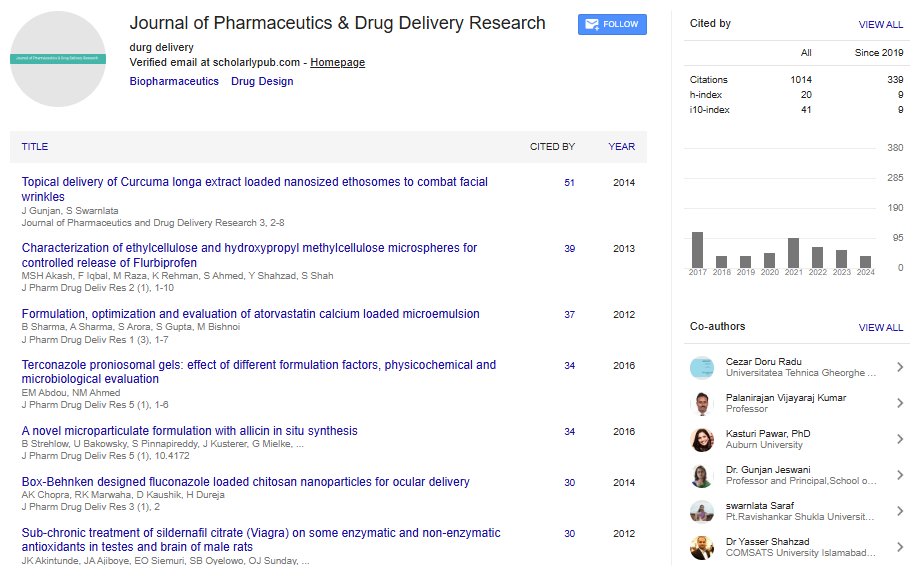Perspective, J Pharm Drug Deliv Res Vol: 13 Issue: 5
Bioavailability: Essential Ideas, Significance, and Elements Affecting Absorption
Arvinder Kaur*
1Department of Pharmacology, Shanghai Jiaotong University School of Medicine, Shanghai, China
*Corresponding Author: Arvinder Kaur,
Department of Pharmacology, Shanghai
Jiaotong University School of Medicine, Shanghai, China
E-mail: kaura47@gmail.com
Received date: 26 August, 2024, Manuscript No. JPDDR-24-151929;
Editor assigned date: 28 August, 2024, PreQC No. JPDDR-24-151929 (PQ);
Reviewed date: 11 September, 2024, QC No. JPDDR-24-151929;
Revised date: 18 September, 2024, Manuscript No. JPDDR-24-151929 (R);
Published date: 26 September, 2024, DOI: 10.4172/2325-9604.1000296
Citation: Kaur A (2024) Bioavailability: Essential Ideas, Significance and Elements Affecting Absorption. J Pharm Drug Deliv Res 13:5.
Description
Bioavailability is a precarious concept in pharmacology and medicine, defining the degree to which an active ingredient, such as a drug or nutrient, becomes available to the target tissue after administration. In simpler terms, it’s a measure of how effectively a compound can reach its intended site of action within the body. This process is essential for the therapeutic effectiveness of medications, as it determines the actual dose that enters the systemic circulation and can act upon the body’s tissues. When healthcare providers prescribe medications or when dietary supplements are designed, understanding bioavailability is essential to ensure that the compound achieves its desired effects efficiently and safely.
Bioavailability is typically expressed as a percentage, reflecting the fraction of an administered dose that reaches the bloodstream in its active form. For example, if a drug has 100% bioavailability, the entire dose administered enters the bloodstream, which is usually the case with Intravenous (IV) administration. However, drugs taken orally may have lower bioavailability due to various factors that influence their absorption and metabolism before reaching systemic circulation. This variability in bioavailability can significantly impact the dosing and effectiveness of medications, requiring healthcare professionals to adjust doses based on the route of administration.
Factors affecting bioavailability
The following factors are considered to affect the bioavailabilty.
Route of administration: One of the most influential factors in bioavailability is the method by which a compound is introduced to the body. Intravenous (IV) routes typically offer 100% bioavailability, while oral routes are often lower due to first-pass metabolism and gastrointestinal barriers.
First-pass metabolism: After oral administration, substances are absorbed through the digestive system and transported to the liver via the portal vein. Here, they undergo metabolism, which can reduce the concentration that reaches the bloodstream. Drugs with high first-pass metabolism may have significantly lower bioavailability compared to those with low first-pass effects.
Solubility and stability: Drugs and nutrients need to be watersoluble to be absorbed efficiently. Additionally, stability within the digestive environment (pH, enzymes) can influence bioavailability. Compounds sensitive to stomach acids or digestive enzymes may degrade before absorption.
Formulation of the drug: The physical form of the drug whether it is in tablets, capsules, or liquid form can affect bioavailability. Some drug formulations are specifically designed to enhance absorption, such as enteric-coated tablets or extended-release capsules.
Food and diet: The presence of food in the stomach can either increase or decrease the bioavailability of certain drugs. Some drugs are more effectively absorbed when taken with food, while others may have decreased bioavailability if taken with particular types of food.
Individual variability: Genetic factors, age, health status and lifestyle habits (e.g., smoking, alcohol consumption) can all influence bioavailability. These differences mean that one dose does not necessarily fit all and healthcare providers often need to tailor treatments to individual needs.
Significance of bioavailability in drug development
Pharmaceutical companies carefully study bioavailability when developing new drugs. This factor is essential for determining dosing, efficacy and safety profiles. Drugs with poor bioavailability may require higher doses or alternative routes of administration to achieve therapeutic effects, which can lead to increased side effects and cost. During clinical trials, bioavailability is analyzed to refine formulations and improve patient outcomes, balancing the therapeutic benefits with potential risks.
Strategies to improve bioavailability
Various techniques can be used to enhance the bioavailability of drugs and nutrients. Some common methods include:
Nanotechnology and lipid-based formulations: Utilizing nanoparticles or lipid-based carriers, such as liposomes, can protect the drug from degradation and improve absorption by enhancing solubility and stability.
Prodrug approaches: A prodrug is an inactive compound that metabolizes into an active drug once in the body. This approach can increase bioavailability by altering the absorption characteristics of the drug.
Co-administration with enhancers: Some substances can increase the bioavailability of drugs by inhibiting enzymes responsible for metabolism or enhancing absorption. An example is piperine, which can increase the bioavailability of curcumin.
Conclusion
Bioavailability plays a pivotal role in ensuring that drugs and nutrients reach their intended targets in effective concentrations. Understanding the factors influencing bioavailability and methods to enhance it allows healthcare providers and pharmaceutical researchers to optimize treatment outcomes. As technology advances, innovative approaches to improving bioavailability continue to enhance patient care, making medications more effective and accessible.
 Spanish
Spanish  Chinese
Chinese  Russian
Russian  German
German  French
French  Japanese
Japanese  Portuguese
Portuguese  Hindi
Hindi 
